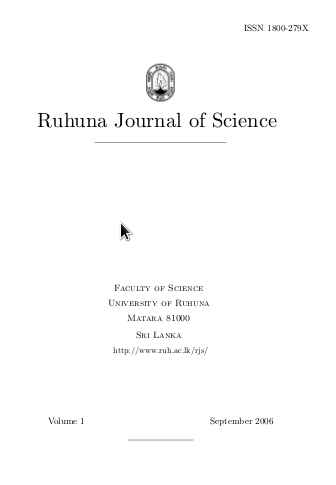Intra-specific morphological plasticity in three Puntius species in Sri Lanka
Abstract
Phenotype of an organism is a result of interaction of genotype and environment. Individuals of a same species living in variety of habitats may subject to different environmental conditions. As a result, they may adapt to local conditions in those habitats which include the changes in morphology from the common phenotype. Different morphologies in individuals of same genotype is called phenotypic plasticity. This is considered as an important event in evolutionary ecology because these individuals are the first to subject to natural selection. Present study focused on phenotypic plasticity in three freshwater fish species namely Puntius dorsalis, P. vitatus and P. bimaculatus. Fish were sampled from different locations in four different altitude ranges of five major rivers of Sri Lanka. Twenty three length measurements and fifteen meristic characters were recorded from each individual and fourteen physicochemical parameters of each location were also measured. Relationship between altitude range and the species morphology was analysed by discriminant analysis and hierachical cluster analysis. Correlation of physicochemical parameters with the altitude range was also studied. Results showed that individuals living in different altitude ranges in different rivers and also in the same river were morphologically different. Results indicated that length characters which determine the shape of the individual mainly con- tribute to the discrimination of individuals according to their respective altitude range. Ratios of maximum body width to standard length, pre ventral length to post ventral length and fork length to standard length in P. dorsalis, P. vitatus and P. bimaculatus respectively were the main discrimination characters that grouped the individuals according to the respective altitudes. Variations in length characters were found to be adaptations to their habitat.Most physicochemical parameters were significantly correlated (negatively or positively) according to the altitude ranges where three species were collected. Phenotypic plasticity in the three Puntius species inhabiting different altitudes may have resulted as an adaptation to these variable physicochemical parameters.References
Abrams PA. 2003. Can adaptive evolution or behaviour lead to diversification of traits determining a trade-off between foraging gain and predation risk? Evolutionary Ecology Research 5:653-670
Beacham TD. 1990. A genetic analysis of meristic and morphometric variation in chum salmon (Oncorhynchus keta) at three different temperatures. Canadian Journal of Zoology 68: 225-229
Barlow GW. 1961. Causes and significance of morphological variation in fishes. Systematic Zoology 10: 105-117
Brinsmead J and Fox MG. 2003. Morphological variation between lake- and streamdwelling rock bass and pumpkinseed populations. Journal of Fish Biology 61:1619-1638
Br¨onmark C. and Miner JG. 1992. Predator-induced phenotypical change in body morphology in crucian carp. Science 258: 1348-1350
Carvalho GR. 1993. Evolutionary aspects of fish distribution: genetic variability and adaptation. Journal of Fish Biology 43 (Suppl A): 53-73
Chapman LJ., Chapman CA., Brazeau DA., McLaughlin B. and Jordan, M. 1999.
Papyrus swamps, hypoxia and faunal diversification: variation among populations of Barbus neumayeri. Journal of Fish Biology 54:310-327
Chapman LJ. and Liem K.F. 1995. Papyrus swamps and the respiratory ecology of Barbus neumayeri. Environment and Biology of Fishes 44:183-197
Corti M., Loy A. and Cataudella S. 1996. Form changes in sea bass, Dicentrachus labrax (Moronidae: Teleostei), after acclimatation to freshwater: an analysis using shape coordinates. Enviornmental Biology of fishes 47: 165-175
Day T. andMcPhail JD. 1996. The effect of behavioural and morphological plasticity on foraging efficiency in the three spine stickleback (Gasterosteus sp.). Oecologia 108:380-388
Day T. Pritchard J. and Schluter D. 1994. A comparison of two sticklebacks. Evolution 48:1723-1734
Goulding M., Carvalho ML. and Ferreira EG. 1988. Rio Negro: rich life in poor water. Hague, the Netherlands: SPB Academic Publishing.
Jerry DR. and Cairns SC. 1998. Morphological variability in the catadromous Australian bass, Macquaria novemaculeata (Perciformes: Percichthyidae), from seven geographically distinct riverine drainages. Journal of Fish Biology 52: 829-843
Jonsson B. and Jonsson N. 2001. Polymorphism and speciation in Arctic charr. Journal of Fish Biology 58:605-638
Kinsey ST., Orsoy T., Bert T.M. and Mahmoudi B. 1994. Population structure of the Spanish sardine Sardinella aurita: natural morphological variation in a genetically homogenous population. Marine Biology 118: 309-317
Lindsay CC. 1981. Stocks are chameleons: plasticity in gill rakers of Corrigonid fishes. Canadian Journal of Fisheries and Aquatic Sciences 38:1497-1506
Lowe-McConnell RH. 1987. Ecological Studies in Tropical Fish Communities. Cambridge: Cambridge University Press
Magnan P. 1988. Interactions between Brook charr, Salvelinus fontinalis, and nonsalmonid species: ecological shift, morphological shift, and their impact on zooplankton communities. Canadian Journal of Fisheries and Aquatic Science 45:999-1009
Robinson BW. and Wilson DS. 1994. Character release and displacement in fishes: A neglected literature. American Naturalist 144:596-627
Downloads
Published
Issue
Section
License
From Volume 7 (2016) onwards, all articles published in Ruhuna Journal of Science are Open Access articles published under the Creative Commons CC BY-NC 4.0 International License. This License permits use, distribution and reproduction in any medium, provided the original work is properly cited and is not used for commercial purposes.
Copyright on any research article published in RJS is retained by the respective author(s).
Authors who publish with this journal agree to the following terms:
a) Authors retain copyright and grant the journal right of first publication with the work simultaneously licensed under a Creative Commons Attribution License CC-BY-NC 4.0 International, that allows others to share the work with an acknowledgement of the work's authorship and initial publication in this journal.
b) Authors are able to enter into separate, additional contractual arrangements for the non-exclusive distribution of the journal's published version of the work (e.g., post it to an institutional repository or publish it in a book), with an acknowledgement of its initial publication in this journal.
c) Authors are permitted and encouraged to post their work online (e.g., in institutional repositories or on their website) prior to and during the submission process, as it can lead to productive exchanges, as well as earlier and greater citation of published work (See The Effect of Open Access).

